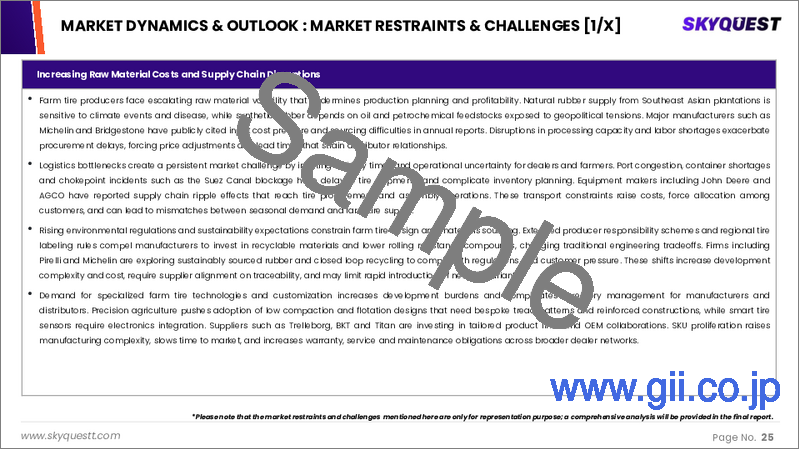|
|
市場調査レポート
商品コード
1651723
農業用タイヤの市場規模、シェア、成長分析:デザイン別、用途別、サイズ別、空気圧別、用途別、地域別 - 産業予測 2025~2032年Farm Tire Market Size, Share, and Growth Analysis, By Design (Radial Tires, Bias Ply Tires), By Application (Tractors, Combine Harvesters), By Size, By Pressure, By Usage, By Region - Industry Forecast 2025-2032 |
||||||
|
|||||||
| 農業用タイヤの市場規模、シェア、成長分析:デザイン別、用途別、サイズ別、空気圧別、用途別、地域別 - 産業予測 2025~2032年 |
|
出版日: 2025年02月06日
発行: SkyQuest
ページ情報: 英文 202 Pages
納期: 3~5営業日
|
全表示
- 概要
- 目次
農業用タイヤ市場規模は2023年に84億米ドルで、予測期間(2025-2032年)のCAGRは5.5%で、2024年の88億6,000万米ドルから2032年には136億米ドルに成長する見通しです。
市場セグメンテーションによると、農業用タイヤ分野は、農業用車両からの需要の増加とセクターの拡大により、力強い成長が見込まれています。生産性を向上させ、食糧需要の増加に対応するために農家が採用している技術の進歩が、この成長の中心となっています。対象となるトラクターに25%の補助金を提供するインドの「農業マクロ管理スキーム」や、土地やトラクターに50万米ドルまでの融資を農家に提供するカナダの「カナダ農業融資法」など、政府の主な取り組みが市場の需要をさらに刺激しています。さらに、労働コストが上昇する中、農家が収量と品質を向上させるために先進設備に投資するため、耐パンク性や耐摩耗性などの特性を備えた耐久性の高いタイヤへのニーズが高まると思われます。全体として、米国の農業用タイヤ市場は予測期間中に大幅な持続的成長を記録すると予想されます。
目次
イントロダクション
- 調査の目的
- 調査範囲
- 定義
調査手法
- 情報調達
- 二次と一次データの方法
- 市場規模予測
- 市場の前提条件と制限
エグゼクティブサマリー
- 世界市場の見通し
- 供給と需要の動向分析
- セグメント別機会分析
市場力学と見通し
- 市場概要
- 市場規模
- 市場力学
- 促進要因と機会
- 抑制要因と課題
- ポーターの分析
主な市場の考察
- 重要成功要因
- 競合の程度
- 主な投資機会
- 市場エコシステム
- 市場の魅力指数(2024年)
- PESTEL分析
- マクロ経済指標
- バリューチェーン分析
- 価格分析
農業用タイヤ市場規模:デザイン別& CAGR(2025-2032)
- 市場概要
- ラジアルタイヤ
- バイアスプライタイヤ
- 特殊タイヤ(ロープロファイル、ハイフロート)
農業用タイヤ市場規模:用途別& CAGR(2025-2032)
- 市場概要
- トラクター
- コンバイン
- 噴霧器
- その他の農業機械
農業用タイヤ市場規模:サイズ別& CAGR(2025-2032)
- 市場概要
- 16インチ未満
- 16~24インチ
- 25インチ以上
農業用タイヤ市場規模:空気圧別& CAGR(2025-2032)
- 市場概要
- 標準圧力タイヤ(60 PSI未満)
- 高圧タイヤ(60~100 PSI)
- 超高圧タイヤ(100 PSI以上)
農業用タイヤ市場規模:用途別& CAGR(2025-2032)
- 市場概要
- 標準的な使用
- 拡張使用(高速フィールド)
- 特殊用途(オフロード)
農業用タイヤ市場規模:地域別& CAGR(2025-2032)
- 北米
- 米国
- カナダ
- 欧州
- ドイツ
- スペイン
- フランス
- 英国
- イタリア
- その他欧州地域
- アジア太平洋地域
- 中国
- インド
- 日本
- 韓国
- その他アジア太平洋地域
- ラテンアメリカ
- ブラジル
- その他ラテンアメリカ地域
- 中東・アフリカ
- GCC諸国
- 南アフリカ
- その他中東・アフリカ
競合情報
- 上位5社の比較
- 主要企業の市場ポジショニング(2024年)
- 主な市場企業が採用した戦略
- 最近の市場動向
- 企業の市場シェア分析(2024年)
- 主要企業の企業プロファイル
- 企業の詳細
- 製品ポートフォリオ分析
- 企業のセグメント別シェア分析
- 収益の前年比比較(2022-2024)
主要企業プロファイル
- Bridgestone Corporation(Japan)
- Michelin(France)
- Titan International Inc.(US)
- Continental AG(Germany)
- BKT Tires(India)
- Trelleborg AB(Sweden)
- Nokian Tyres PLC(Finland)
- Pirelli & C SpA(Italy)
- Alliance Tire Group(India)
- Apollo Tyres Ltd.(India)
- Magna Tyres Group(Netherlands)
- CEAT Ltd.(India)
- JK Tyre & Industries Ltd.(India)
- MRF Limited(India)
- Yokohama Rubber Co., Ltd.(Japan)
- Sumitomo Rubber Industries, Ltd.(Japan)
- Goodyear Tire & Rubber Company(US)
- Cooper Tire & Rubber Company(US)
- Cheng Shin Rubber Ind. Co., Ltd.(Taiwan)
- Maxxis International Co., Ltd.(Taiwan)
結論と提言
Farm Tire Market size was valued at USD 8.4 billion in 2023 and is poised to grow from USD 8.86 billion in 2024 to USD 13.6 billion by 2032, growing at a CAGR of 5.5% during the forecast period (2025-2032).
Market insights indicate that the farm tyre segment is poised for robust growth driven by increasing demand from agricultural vehicles and sector expansion. Technological advancements adopted by farmers to enhance productivity and meet rising food demands are central to this growth. Key government initiatives, such as India's "Macro-Management Scheme of Agriculture," which offers a 25% subsidy for eligible tractors, and Canada's "Canadian Agricultural Loans Act," providing farmers loans up to USD 500,000 for land or tractors, further stimulate market demand. Additionally, as farmers invest in advanced equipment to boost yield and quality amid rising labor costs, the need for durable tyres-with characteristics like puncture and wear resistance-will rise. Overall, the US Farm Tire Market is expected to register significant sustainable growth in the forecast period.
Top-down and bottom-up approaches were used to estimate and validate the size of the Farm Tire market and to estimate the size of various other dependent submarkets. The research methodology used to estimate the market size includes the following details: The key players in the market were identified through secondary research, and their market shares in the respective regions were determined through primary and secondary research. This entire procedure includes the study of the annual and financial reports of the top market players and extensive interviews for key insights from industry leaders such as CEOs, VPs, directors, and marketing executives. All percentage shares split, and breakdowns were determined using secondary sources and verified through Primary sources. All possible parameters that affect the markets covered in this research study have been accounted for, viewed in extensive detail, verified through primary research, and analyzed to get the final quantitative and qualitative data.
Farm Tire Market Segments Analysis
Global Farm Tire Market is segmented by Design, Application, Size, Pressure, Usage and region. Based on Design, the market is segmented into Radial Tires, Bias Ply Tires and Specialty Tires (Low-profile, High-flotation). Based on Application, the market is segmented into Tractors, Combine Harvesters, Sprayers and Other Farm Equipment. Based on Size, the market is segmented into Less than 16 inches, 16 to 24 inches and 25 inches and above. Based on Pressure, the market is segmented into Standard Pressure Tires (Less than 60 PSI), High Pressure Tires (60 to 100 PSI) and Very High Pressure Tires (over 100 PSI). Based on Usage, the market is segmented into Standard Usage, Extended Usage (High-speed field operations) and Specialty Usage (Off-road applications). Based on region, the market is segmented into North America, Europe, Asia Pacific, Latin America and Middle East & Africa.
Driver of the Farm Tire Market
The global trend toward agricultural mechanization is gaining momentum, as farmers increasingly utilize advanced machinery and equipment to enhance the efficiency of their farming operations. This surge in mechanization is significantly influencing the demand for farm tires, which are essential for providing the necessary support and traction for a variety of agricultural machinery, including tractors, combines, harvesters, and sprayers. As the industry continues to evolve and more farmers embrace innovative technologies, the need for durable and high-performance farm tires is expected to grow, further propelling the market forward and ensuring optimal performance for modern agricultural practices.
Restraints in the Farm Tire Market
The farm tire market is significantly affected by variations in agricultural commodity prices. When these prices dip, farmers often encounter financial challenges, leading them to postpone or decrease their investments in essential equipment, such as farm tires. Additionally, economic uncertainties and the inherent volatility in the agricultural sector can further diminish the demand for these tires. Consequently, the financial health of farmers and the broader economic landscape are crucial factors that can restrain growth in the farm tire market, as they directly influence purchasing behavior and the overall level of investment in agricultural machinery.
Market Trends of the Farm Tire Market
The farm tire market is experiencing a notable shift towards radial tires, driven by their superior performance characteristics that enhance agricultural efficiency. Farmers are recognizing the advantages of radial tires, including enhanced traction, minimized soil compaction, improved ride comfort, and greater fuel efficiency. This trend reflects a broader understanding of sustainable farming practices, as reducing soil impact is crucial for long-term productivity. The increasing demand for radial tires is reshaping purchasing behaviors, with more agricultural stakeholders investing in advanced tire technology to optimize their operations, thereby solidifying radial tires' position as the preferred choice in modern farming practices.
Table of Contents
Introduction
- Objectives of the Study
- Scope of the Report
- Definitions
Research Methodology
- Information Procurement
- Secondary & Primary Data Methods
- Market Size Estimation
- Market Assumptions & Limitations
Executive Summary
- Global Market Outlook
- Supply & Demand Trend Analysis
- Segmental Opportunity Analysis
Market Dynamics & Outlook
- Market Overview
- Market Size
- Market Dynamics
- Drivers & Opportunities
- Restraints & Challenges
- Porters Analysis
- Competitive rivalry
- Threat of substitute
- Bargaining power of buyers
- Threat of new entrants
- Bargaining power of suppliers
Key Market Insights
- Key Success Factors
- Degree of Competition
- Top Investment Pockets
- Market Ecosystem
- Market Attractiveness Index, 2024
- PESTEL Analysis
- Macro-Economic Indicators
- Value Chain Analysis
- Pricing Analysis
Global Farm Tire Market Size by Design & CAGR (2025-2032)
- Market Overview
- Radial Tires
- Bias Ply Tires
- Specialty Tires (Low-profile, High-flotation)
Global Farm Tire Market Size by Application & CAGR (2025-2032)
- Market Overview
- Tractors
- Combine Harvesters
- Sprayers
- Other Farm Equipment
Global Farm Tire Market Size by Size & CAGR (2025-2032)
- Market Overview
- Less than 16 inches
- 16 to 24 inches
- 25 inches and above
Global Farm Tire Market Size by Pressure & CAGR (2025-2032)
- Market Overview
- Standard Pressure Tires (Less than 60 PSI)
- High Pressure Tires (60 to 100 PSI)
- Very High Pressure Tires (Over 100 PSI)
Global Farm Tire Market Size by Usage & CAGR (2025-2032)
- Market Overview
- Standard Usage
- Extended Usage (High-speed field operations)
- Specialty Usage (Off-road applications)
Global Farm Tire Market Size & CAGR (2025-2032)
- North America (Design, Application, Size, Pressure, Usage)
- US
- Canada
- Europe (Design, Application, Size, Pressure, Usage)
- Germany
- Spain
- France
- UK
- Italy
- Rest of Europe
- Asia Pacific (Design, Application, Size, Pressure, Usage)
- China
- India
- Japan
- South Korea
- Rest of Asia-Pacific
- Latin America (Design, Application, Size, Pressure, Usage)
- Brazil
- Rest of Latin America
- Middle East & Africa (Design, Application, Size, Pressure, Usage)
- GCC Countries
- South Africa
- Rest of Middle East & Africa
Competitive Intelligence
- Top 5 Player Comparison
- Market Positioning of Key Players, 2024
- Strategies Adopted by Key Market Players
- Recent Developments in the Market
- Company Market Share Analysis, 2024
- Company Profiles of All Key Players
- Company Details
- Product Portfolio Analysis
- Company's Segmental Share Analysis
- Revenue Y-O-Y Comparison (2022-2024)
Key Company Profiles
- Bridgestone Corporation (Japan)
- Company Overview
- Business Segment Overview
- Financial Updates
- Key Developments
- Michelin (France)
- Company Overview
- Business Segment Overview
- Financial Updates
- Key Developments
- Titan International Inc. (US)
- Company Overview
- Business Segment Overview
- Financial Updates
- Key Developments
- Continental AG (Germany)
- Company Overview
- Business Segment Overview
- Financial Updates
- Key Developments
- BKT Tires (India)
- Company Overview
- Business Segment Overview
- Financial Updates
- Key Developments
- Trelleborg AB (Sweden)
- Company Overview
- Business Segment Overview
- Financial Updates
- Key Developments
- Nokian Tyres PLC (Finland)
- Company Overview
- Business Segment Overview
- Financial Updates
- Key Developments
- Pirelli & C SpA (Italy)
- Company Overview
- Business Segment Overview
- Financial Updates
- Key Developments
- Alliance Tire Group (India)
- Company Overview
- Business Segment Overview
- Financial Updates
- Key Developments
- Apollo Tyres Ltd. (India)
- Company Overview
- Business Segment Overview
- Financial Updates
- Key Developments
- Magna Tyres Group (Netherlands)
- Company Overview
- Business Segment Overview
- Financial Updates
- Key Developments
- CEAT Ltd. (India)
- Company Overview
- Business Segment Overview
- Financial Updates
- Key Developments
- JK Tyre & Industries Ltd. (India)
- Company Overview
- Business Segment Overview
- Financial Updates
- Key Developments
- MRF Limited (India)
- Company Overview
- Business Segment Overview
- Financial Updates
- Key Developments
- Yokohama Rubber Co., Ltd. (Japan)
- Company Overview
- Business Segment Overview
- Financial Updates
- Key Developments
- Sumitomo Rubber Industries, Ltd. (Japan)
- Company Overview
- Business Segment Overview
- Financial Updates
- Key Developments
- Goodyear Tire & Rubber Company (US)
- Company Overview
- Business Segment Overview
- Financial Updates
- Key Developments
- Cooper Tire & Rubber Company (US)
- Company Overview
- Business Segment Overview
- Financial Updates
- Key Developments
- Cheng Shin Rubber Ind. Co., Ltd. (Taiwan)
- Company Overview
- Business Segment Overview
- Financial Updates
- Key Developments
- Maxxis International Co., Ltd. (Taiwan)
- Company Overview
- Business Segment Overview
- Financial Updates
- Key Developments





